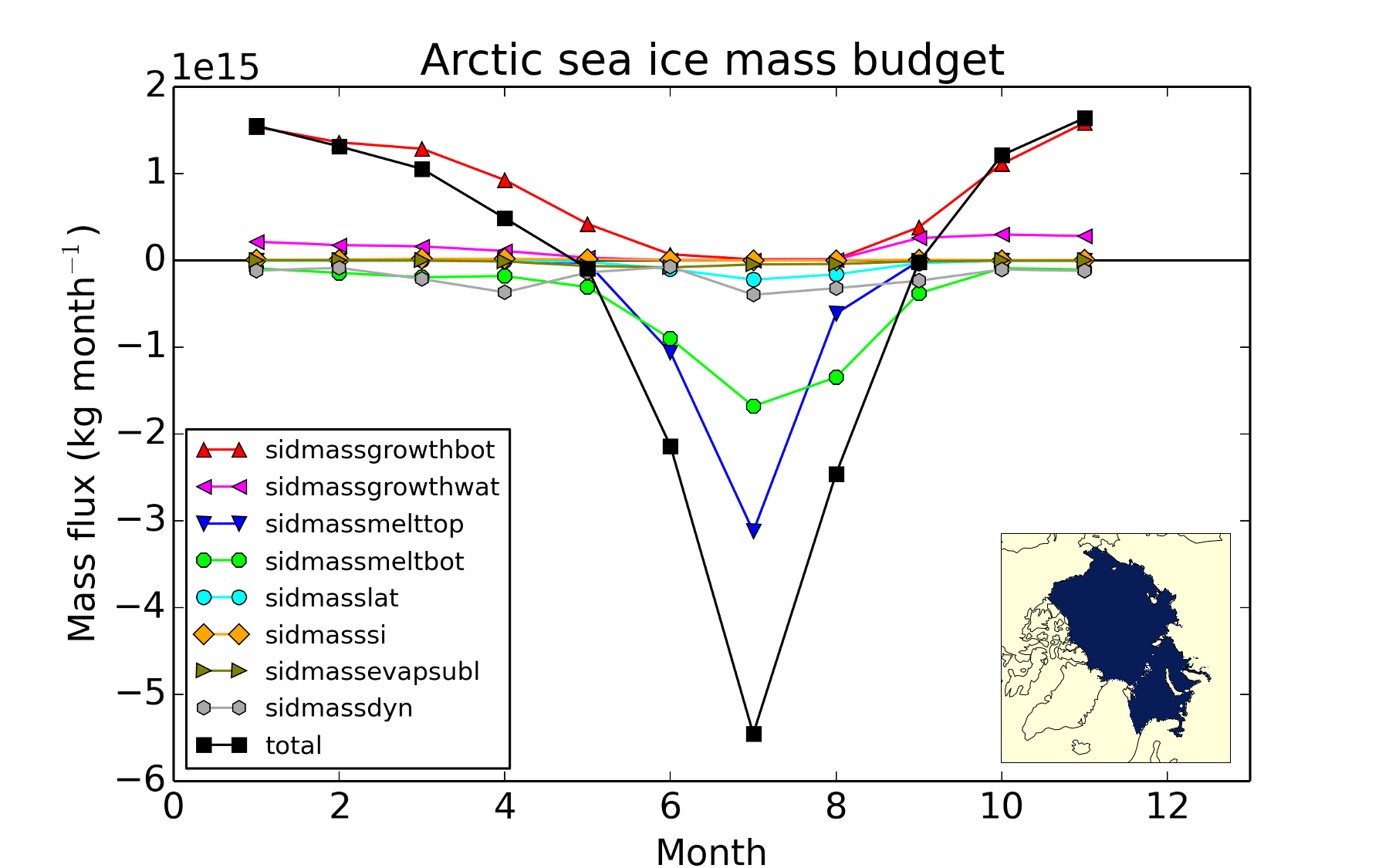A Sea-Ice Model inter-comparison Project of the mass budget of Arctic sea ice and snow in CMIP6 models
 Sea ice is a key component of the global climate system, and a very visible indicator of climate change. Arctic summer sea ice cover has declined at a rate of over 13% per decade since satellite observation began, and there is much interest in how this decline will continue in the future. Global coupled models are arguably the best tool we have for making future projections of Arctic sea ice, but generate a wide spread of projections of future decline.
Sea ice is a key component of the global climate system, and a very visible indicator of climate change. Arctic summer sea ice cover has declined at a rate of over 13% per decade since satellite observation began, and there is much interest in how this decline will continue in the future. Global coupled models are arguably the best tool we have for making future projections of Arctic sea ice, but generate a wide spread of projections of future decline.
Several previous CMIP analyses/studies have attempted to decrease the spread of plausible future projections by sub-selecting models based on their ability to simulate current day sea ice and/or past observed changes. However, such an approach ignores the considerable influence of internal variability in the Arctic climate system as well as the existence of cancelling errors in models and the potential for these to change in climate simulations as the system warms.
Comparing frequently analysed integrated quantities - such as ice extent and volume - alone is not sufficient to understand the reasons for differences in model projections. It is becoming increasingly clear that it is also necessary to consider, compare and evaluate the underlying processes causing ice growth and decline, and how they are likely to change in a warming world.
For CMIP6 models, the extra sea ice budget diagnostics that are included in the SIMIP data request (Notz et al., 2016) will allow much easier inter-model comparison of these underlying processes via an evaluation of the sea ice mass/volume budget. Improved knowledge of the sea ice volume/mass budget in climate models will help us to better understand the spread in climate simulations and the drivers of Arctic sea ice decline.
Here we propose a methodology for inter-comparing the mass budget of the Arctic sea ice, and how it changes during the 21st century, in CMIP6 model projections. This is based on the analysis of Keen and Blockley (2018) (K&B18), who investigated 21st century changes in the volume budget of the Arctic sea ice in the CMIP5 model HadGEM2-ES.
We propose that an extension of the analysis of K&B18 is performed using a number of CMIP6 models, and the results submitted to a peer-reviewed journal in time to be considered for inclusion in the IPCC AR6 report. The aim would be for participating modelling centres to calculate area-weighted monthly mean mass budget terms, along with the volume, mass and area of ice and snow over a defined region of the Arctic for the period 1960-2100. The broad plan would then be to compare the following:
- The seasonal cycle of budget components for the chosen reference period (1960-89?) (c.f. K&B18 Figure 4b)
- The evolution of the decadal mean budget components (c.f. K&B18 Figures 4a and 5)
- The changes in the seasonal cycle for each decade relative to the reference decade (c.f. K&B18 Figure 6)
- Evolution of (changes in) the budget terms as a function of (changes in) ice cover (c.f. K&B18 Figures 9 and 10): how robust are these relationships between models?
What we do after this will depend on the results – what interesting changes are found? Can these be traced back to particular parametrisations or known limitations/biases of particular models?
We propose to evaluate the budgets of the snow and ice separately where possible, but also to consider the combined budget as in K&B18. Modelling centres can choose only to calculate the combined budget if they prefer. Analysis will initially focus on the Historical and SSP5-8.5 scenario runs.
The following SIMIP monthly diagnostics will be used:
Ice and snow state:- siconc (sea-ice area fraction)
- sithick (sea ice thickness (m))
- sisnthick (snow thickness (m))
- sisnconc (fraction of sea-ice surface covered by snow)
- simass sea ice mass per area (mass of sea ice/grid cell area kg m-2)
- sidmassth (sea ice mass change from thermodynamics/grid-cell area kg m-2 s-1)
- sidmassdyn (sea ice mass change from dynamics/grid-cell area kg m-2 s-1)
- sidmassgrowthwat (rate of change of sea ice mass due to frazil ice formation/grid-cell area kg m-2 s-1)
- sidmassgrowthbot (rate of change of sea ice mass due to growth at the base of existing ice/grid-cell area kg m-2 s-1)
- sidmasssi (rate of change of sea ice mass due to transformation of snow to sea ice/grid-cell area kg m-2 s-1)
- sidmassevapsubl (rate of change of sea ice mass due to evaporation and sublimation/grid-cell area kg m-2 s-1)
- sidmassmelttop (rate of change of sea ice mass due to melting at the top surface/grid-cell area kg m-2 s-1)
- sidmassmeltbot (rate of change of sea ice mass due to melting at the bottom surface/grid-cell area kg m-2 s-1)
- sidmasslat (rate of change of sea ice mass due to lateral melting/grid-cell area kg m-2 s-1)
- sisnmass (snow mass/grid-cell area, kg m-2)
- sndmasssnf (mass of solid precip falling onto sea ice/grid-cell area kg m-2 s-1)
- sndmassmelt (rate of change of snow mass through melt/grid-cell area kg m-2 s-1)
- sndmasssubl (rate of change of snow mass through sublimation/grid-cell area kg m-2 s-1)
- sndmassdyn(rate of change of snow mass through advection/grid-cell area kg m-2 s-1)
- sndmasssi (rate of change of snow mass through snow ice conversion/grid-cell area kg m-2 s-1)
- sndmasswindrif (rate of change of snow mass through wind drift (into ocean)/grid-cell area kg m-2 s-1)
Since each modelling centre is most familiar with their own model and grid, we propose that participants supply the following as monthly means for each month of each year from 1960 to 2100 inclusive, from the historical and scenario simulations – with priority given to the SSP5-8.5 scenario. Any terms that are not relevant (for example processes not explicitly modelled) should be left as zero.
- total mass of sea ice (kg): sum over grid-cells of simass*grid-cell area
- rate of change of sea ice mass (kg s-1) for each tendency term: for example the mean mass change due to thermodynamics would be the sum over grid-cells of simassth*grid-cell area.
- total mass of snow on sea ice (kg): sum over grid-cells of sisnmass*grid-cell area
- mean rate of change of snow mass (kg s-1) for each tendency term: for example the mean mass change due to advection would be the sum over grid-cells of sndmassdyn*grid-cell area.
- Total area covered by sea ice (sum over gridcells of siconc*grid-cell area)
- Total area covered by snow (sum over gridcells of sisnconc*siconc*gridcell area)
- Total volume of sea ice (m3) (sum over gridcells of (sithick/siconc)*grid-cell area)
- Total volume of snow on sea ice (m3) (sum over gridcells of (sisnthick/(sisnconc*siconc)*grid-cell area)
The Met Office has supplied the following:
- Instructions for joining the inter-comparison (pdf)
- Template ascii files for the provision of mass budget data (ice, snow)
- Definition of the Arctic regional mask and example netcdf files on various grids (eORCA1; eORCA025; EASE)
- Example python code for reading/writing the mass-budget ascii files and texting budget closure
If you are interested in participating in this budget inter-comparison activity, then please contact either Ann Keen or Ed Blockley.
Keen, A. and Blockley, E.: Investigating future changes in the volume budget of the Arctic sea ice in a coupled climate model, The Cryosphere, 12, 2855-2868, doi:10.5194/tc-12-2855-2018, 2018.
Notz, D., Jahn, A., Holland, M., Hunke, E., Massonet, F., Stroeve, J., Tremblay, B. and Vancoppenolle, M.: The CMIP6 Sea-Ice Model Intercomparison Project (SIMIP): understanding sea ice through climate-model simulations, Geosci. Model Dev., 9, 3427–3446. doi:10.5194/gmd-9-3427-2016, 2016.
